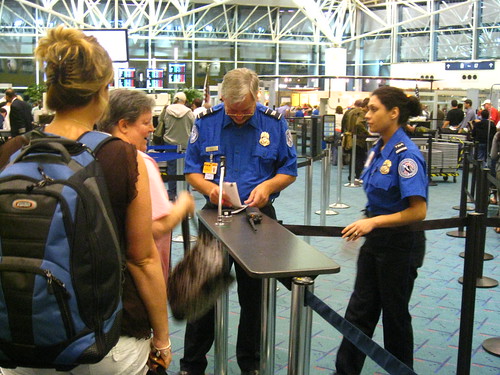
I’m a big fan of the Harrison Ford movie, The Fugitive. During the movie, Ford faked an ID card, having stolen a real one, to get into the Cook County Hospital prosthetics department. Posing as a janitor in a stolen uniform, he obtained a list of people who had their prosthetic arm repaired shortly after his wife’s murder. If you’ve seen the movie, you know, he’s looking for the infamous “One-armed man.”
Any thinking person will concede that if you put a person in a legitimate uniform, with a legitimate-looking ID, (an altered original, or forged ID from an original), they will generally have no difficulty getting through security, at least for a while. What’s more, a terrorist, impersonating a security person, only has to get through security once.
How come the Transportation Security Administration (TSA) still has not figured this out?
I think we can agree that TSA officers and baggage screeners are an important part of the US’ first line of defense in the war against terror. They receive significant training to keep terrorists and dangerous materials which can be turned into weapons, off commercial airplanes.
TSA officer and baggage screener uniforms and identification badges give these federal employees a free pass at airport security.
By the end of 2006 more than 4,000 TSA uniforms and identification badges were reported lost or stolen. Amy Kudwa, TSA spokesperson, said the stolen uniforms and ID badges pose no threat to national security. She explained they represent one of several layers of security at airports. OK, it is one of several layers, but once a terrorist, with a stolen uniform and ID, passes through security at the airport, without having their belongings or person checked via x-ray, magnetometer, explosion sniffer, or pat-down, then all bets are off!
Airline consultant Michael Boyd asks, if TSA can’t maintain security over their uniforms and ID badges, how well can they actually maintain security of the airports?
That sounds like a great question to me.
In April 2008, the Chicago Sun Times reported that uniforms belonging to Transportation Security Administration officers were left out in the open at an O’Hare Airport checkpoint along with sensitive security information.
Homeland Security’s own Inspector General (IG), Richard L. Skinner also disagrees with Ms. Kudwa’s assessment. He wrote, in September 2008,
The Transportation Security Administration does not have adequate controls in place to manage and account for airport security identification display area badges, uniforms, and identification cards provided to its employees. Unauthorized individuals’ access to those items increases an airport’s level of risk to a wide variety of terrorist and criminal acts.
Last September, the Department of Homeland Security, Office of the Inspector General issued the report Transportation Security Administration’s Controls over SIDA Badges, Uniforms, and Identification Cards. In the highly redacted report, the Inspector General recommends,
that the Assistant Secretary, Transportation Security Administration, strengthen management controls over airport security identification display area badges, uniforms, and identification cards.
That same month, TSA introduced their new uniforms and badges to great fanfare stating, in part,
The new uniform addresses officers’ concerns of utility, respect, and confidence, and will stand as a readily identifiable symbol of TSA’s security mission and officers’ role of keeping the traveling public safe.
How can the flying public respect TSA if they, themselves, don’t respect their important symbols?
Unfortunately, the problems aren’t confined to stolen TSA uniforms and identification. KOMO TV, Seattle, Washington, reported in November, 2008, that former TSA officers and baggage screeners have been keeping their uniforms and security badges long after they’ve left their jobs.
One officer had an active pass to secure areas 827 days after leaving the TSA. In 73 cases, offices that monitor security passes weren’t notified when an employee quit. And the agency lost track of former security officers’ uniforms 82 times.
It’s been a year since the IG report, which is plenty of time to rectify the situation. The only problem is, the cavalier attitude of TSA remains.
At Philadelphia International Airport (PHL) CBS3 reported, just this past week, after waiting 2 years for the information, that from 2003 through 2007, 34 former PHL TSA employees walked away with uniforms, and 7 ID badges, and 22 uniforms or parts of uniforms were lost or stolen during that time.
That may be old news now, but at the end of the report sent to CBS3, Ann Davis, spokesperson for TSA, said, “Lost or missing TSA badges and uniforms are not a security concern.”
TSA continues to thumb their nose at their own Department of Homeland Security’s Inspector General. Do they really believe that nonsense?
Arthur Walk, an aviation security expert, says, “When you are as careless as this, you invite an abuse of the system, and that is very risky!”
After many years working in corporate America as a chemical engineer, executive and eventually CFO of a multinational manufacturer, Ned founded a tech consulting company and later restarted NSL Photography, his photography business. Before entering the corporate world, Ned worked as a Public Health Engineer for the Philadelphia Department of Public Health. As a well known corporate, travel and wildlife photographer, Ned travels the world writing about travel and photography, as well as running photography workshops, seminars and photowalks. Visit Ned’s Photography Blog and Galleries.

